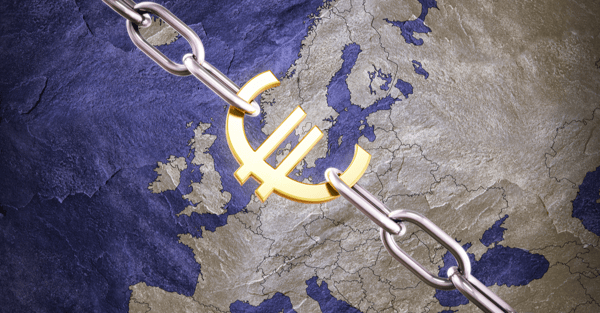The coronavirus pandemic is wreaking havoc on global economies and industries like oil, labour and retail, while exacerbating debt problems in the eurozone.
US economy may shrink by 30% in the first quarter
At least Q1 of the US economy has suddenly gone idle amid the coronavirus pandemic, an unprecedented shutdown of commerce that has never occurred on such a wide scale.
While eight in 10 US counties are under lockdown orders, they represent nearly 96% of national output. Forty-one states have ordered at least some businesses to close to reduce the spread of the coronavirus. Restaurants, universities, gyms, movie theatres, public parks, boutiques and millions of other “nonessential” businesses have shut off the lights as a result. The upshot: US daily output has fallen roughly 29%, compared to the first week of March, just before the spate of closures.
We are not sure if 29% monthly drop in daily output will be sustained over two more months. If it does, gross domestic product would fall at a roughly 75% annual rate in the second quarter. Many counties will reopen before the summer, projecting a 30% annualised decline in second-quarter GDP.
Most economists expect output to pick up this summer or in the fall, as states reopen and virus cases drop. But the magnitude of the drop in daily output – however long it lasts – is staggering. Annual output fell 26% between 1929 and 1933, during the Great Depression, Commerce Department data show. Quarterly output fell almost 4% between late 2007 and mid-2009, during the last recession.
The analysis almost certainly underestimates the total hit because it looks only at the lost output caused by the abrupt closure of businesses to date. It does not consider how much output will be further lost due to additional demand-side drops from higher unemployment and the loss of household wealth on household and business spending.
The impact on industries not explicitly closed by government orders, such as home construction, are based on figures from industry analysts. For example, close to 90% of the hotel industry is shut down nationwide, while only 10% of financial services output is shut down.
The current economic crisis is unlike past crises such as the 2007-09 recession, which was caused in large part by a massive run-up in household and business debt and the housing crash. That recession began with what is known as a demand-side shock – a loss of household wealth and income that led to decreased spending, which eventually harmed the supply side, or businesses. This time, the reverse is occurring: The supply side, businesses, are closing first, which is in turn hurting households.
The best comparison to what the economy is going through right now is a massive earthquake, or the terrorist attacks of September 11, 2001, when airlines temporarily stopped flying. In the days after the attacks, US output dropped by an estimated $111 billion in current dollars. By comparison this year, in the roughly three weeks since the state-imposed closures due to the coronavirus outbreak, output has fallen roughly $350 billion.
In the tri-state region of New York, New Jersey and Connecticut, the slowdown is being driven largely by two industries: real estate and retail. In some industries, including food services like restaurants and bars, as well as arts and entertainment, output has fallen by three quarters. We don’t think we’ve ever had a parallel experiment before – even in wartime, the world allocating resources elsewhere.
Business closures will ultimately hurt the demand side of the economy, which in turn will further dent output. The most significant evidence of that, thus far, is layoffs. Roughly 10 million people applied for first-time unemployment benefits in the two weeks through March 28, according to Labour Department figures, shattering previous records. Those workers could ultimately pull back on spending, in turn further hurting other businesses that remain open.
The Federal Reserve will release minutes from its unscheduled meetings on March 3 and March 15, when officials brought the central bank’s benchmark interest rate near zero and launched programs to stabilise the economy. Minutes are likely to reflect a willingness to take additional steps as the outlook deteriorates.
US initial jobless claims are again expected to reflect massive job losses as swaths of the economy shut down. Nearly 10 million Americans – more than the entire labour force of New York state – filed applications for unemployment insurance during the two-week span ending March 28. Figures out on Thursday cover the week ending April 4. Also, University of Michigan’s consumer sentiment index is expected to reflect increasing pessimism about the country’s economic prospects.
More problems hide in eurozone

The euro survived its debt crisis, but the wounds never fully healed. The coronavirus is threatening to reopen them. Fighting the pandemic is causing deep plunges in economic activity around the world and pushing up government deficits. Stable access to borrowing is vital for governments that know they will have to cope with a surge in debt for the second time since 2008.
In Europe’s common currency zone, an old gap is being exposed: between financially secure northern countries such as Germany and the Netherlands, and southern countries whose ability to borrow is more fragile, such as Italy and Spain. Southern eurozone nations have less money to prop up their households and businesses during the health emergency, risking greater economic damage and a weaker recovery afterward.
The gap is leading to clashing proposals for European financial support. Northern offers of loans with strings attached strike the south as punitive and inadequate. The South’s clamour to issue joint bonds sounds to the North like a demand to use its credit card.
Recriminations in March have given way this week to a greater understanding in Northern Europe for the loss caused by the pandemic. Italy and Spain have between them suffered at least 25,000 deaths from the virus, and their strict lockdowns are pummelling economies that still bear scars from the last financial crisis.
Dutch Finance Minister Wopke Hoekstra, who infuriated southern countries by suggesting their financial limitations stem from their own profligacy, conceded on Tuesday he should have shown more empathy.
Despite the warmer tones, there is still disagreement on what to do. France and the European Union’s executive have tried to offer compromised proposals. A divided eurozone remains. Unless the economic shock of lockdowns is quickly overcome, Italy and Spain are in danger of emerging from the coronavirus crisis as poorer countries. A renewed depression in Southern Europe would also be bad news for northern nations, whose industries and banks profit from the overall health of the region’s economy.
The eurozone has a supranational central bank but national fiscal authorities. Coordinating between those two is much more difficult than in the UK or US. Eurozone fiscal authorities are willing to act but some have more ability to move, others less, and that creates problems for the whole architecture.
Italy’s €2.4 trillion national debt, already 136% of its gross domestic product, is the biggest worry. The path of the pandemic is unpredictable, but some economists say the debt could easily end up at 160% of its GDP. Italy can afford to service such debts if long-term interest rates remain at historic lows – something the pandemic could further entrench. But it would increase the need for tight fiscal policies, putting the brakes on an economic rebound.
A two-speed recovery could exacerbate Italians’ growing disillusion with the EU and the euro. Surveys in recent years showed most Italians don’t want to leave – but also that many believe the bloc and its currency haven’t been good for Italy.
The coronavirus crisis has further damaged the EU’s image in Italy. No other EU country responded to an early Italian request for medical supplies. Germany and some other countries initially blocked deliveries of masks and other equipment. More assistance is now flowing, but only after China and Russia exploited European inaction by sending Italy supplies with much propaganda fanfare.
The European Central Bank exasperated even EU supporters in Italy when its president, Christine Lagarde, said keeping a lid on Italy’s borrowing costs wasn’t the ECB’s job. That sparked a sell-off of Italian debt, since investors think the ECB is vital to keeping eurozone bond markets stable. The ECB quickly corrected its gaffe, announcing a €750 billion program of emergency bond purchases, which calmed markets down.
However, national borrowing with the ECB’s help may not be enough. While leaving it only to the ECB makes the situation more fragile, the bigger this gets, the more ECB purchases can become politically contested, and there can be legal challenges to the ECB in Germany. There needs to be a political acknowledgment that we sit in the same boat. If Italy can’t afford a sufficient fiscal response, it’s not just an issue for Italy but also a major issue for Germany, through interdependence in trade and financial markets.
EU negotiations quickly become a soup of acronyms, buzzwords and treaty articles, but the proposals fall into three broad categories. The Netherlands, chastened by criticism, is proposing financial gifts, but on a tiny scale compared to the eurozone’s €11.9-trillion economy. Germany wants Italy and Spain to use the eurozone’s main bailout fund, which offers loans in exchange for policy conditions. But the loans wouldn’t be much cheaper than bond markets, and they would add to Italy’s already high debt. Additionally, sending EU technocrats to oversee Italy’s economic policies is politically toxic in a country still smarting from EU-mandated austerity during the debt crisis.
Italy, Spain, France and several other countries want a bolder form of burden sharing: for eurozone nations to borrow money jointly and spend it where it is needed most. That would mean Italy’s debts rise by less than the money it receives. But northern countries fear it would set a precedent for a European fiscal union in which their taxpayers subsidise other nations. That is as unpalatable in Germany as EU-imposed austerity is in Italy.
If proposals are perceived as the start of a permanent fiscal union, they are dead immediately. Nobody wants that. If a program is big but specific for the purposes of an extraordinary crisis, that can fly. We predict a compromise that offers sizable help, but less than is needed.
If Europe doesn’t share the debt burden from 2020’s emergency, the ECB may have to buy up southern countries’ extra borrowing and sit on it forever. The debt would remain in national statistics, but as long as the central bank holds it, it ceases to be of economic significance: It’s like a loan between different parts of the public sector.
This is what governments do in wartime. There can be issues of inflation when central banks monetise the debt, but the problem in Europe now will be how to stop a spiral of deflation. Northern eurozone members should support such a solution politically out of self-interest. When the pandemic ends, they need to make sure the eurozone economy can grow again.
Oil market is in a race against time

The postponement of an emergency summit Monday to discuss global supply cuts means producers are more likely to lose that race. As the world’s leading exporters, Saudi Arabia and Russia, continue to trade barbs, a global glut of crude is expanding.
Planes are grounded, streets are empty and factories are shut down. That adds up to a huge fall in demand for oil. But producers in many cases haven’t curtailed production. Now investors say the world could run out of storage for its excess oil in just a few months. Tankers of crude are floating at sea with nowhere to go. And energy companies, which collectively have hundreds of billions of dollars in debt maturing in coming years, are starting to file for bankruptcy.
Following the delay of the summit to discuss supply cuts, Brent crude (the global gauge of oil prices) opened down about 9% at $31.05 a barrel Sunday evening. Markets expect recent volatility to continue, and moves when futures trading open are often more extreme due to limited trading volumes.
Many traders remain sceptical that even an end to a production feud between Saudi Arabia and Russia would give prices a long-term boost. But investors say it could at least help stop the energy sector’s downward spiral. As an initial measure to address the ballooning coronavirus crisis, they are desperate to see massive cuts to global supply.
Prices recovered some ground late last week after President Trump hinted the Saudi-Russia spat could end soon. Officials of the Organization of the Petroleum Exporting Countries (OPEC) then called for Monday’s meeting, but its delay, as a result of discord between Saudi Arabia and Russia and a lack of commitment from US companies about output cuts, could pressure oil prices again. The group is now set to convene on Thursday.
Investors are not ready to boost holdings of energy assets. Many have slashed the investments in the sector to the smallest allocation they’ve ever had. They want to see clarity on the pandemic and more details on supply curbs before even considering increasing it again.
Brent prices ended last week at $34.11 a barrel after sliding on Tuesday to $22.74, its lowest level since 2002. That day, it closed out a 55% March drop that was its largest ever in data going back to 1988.
The S&P 500 energy group plunged 51% in the first quarter; the biggest quarterly decline ever recorded by any of the index’s sectors in figures going back to 1989. Investors have also sold high-yield energy bonds, sending yields skyrocketing in another sign of distress.
Energy shares have clawed back some of their losses recently and were the stock market’s best-performing group last week, making the sector a focus for traders moving forward. The oil market’s meltdown is imperilling crude-producing economies from Nigeria to Venezuela that don’t have the capacity to increase output as Saudi Arabia does. US shale companies are also under pressure.
Many participants expect those measures to not even come close to bringing supply down to meet reduced demand. But they do mark necessary initial steps. US President Trump held calls with Russian President Vladimir Putin and Saudi Arabian Crown Prince Mohammed bin Salman last week before meeting Friday with US energy-industry executives about possible aid to the industry. Some investors are hoping for swift action from all parties after a deal between OPEC and Russia to cut output fell apart last month in Vienna.
The breakup of the OPEC alliance is helping to flood the world with cheap oil that no one can consume because of travel restrictions designed to stop the spread of the coronavirus. As analysts continue crunching numbers on a historic drop in fuel demand, estimates for the daily decline in oil consumption keep rising into the tens of millions of barrels.
To make matters worse, some estimate that roughly 70% of the world’s commercial and strategic stockpiles of crude oil are already filled. As companies try to store oil and ride out the crisis, traders said inventories could soon be filled to the brim. That could force some firms to pay buyers to take away their excess crude.
Such a dire possibility is adding even more pressure on producers and policy makers to act. The sense of urgency is building. Hedge funds and other speculative investors are extremely cautious about a rebound. They lowered net bets on higher Brent prices by 80% during the four weeks ended March 24, Intercontinental Exchange data show. The crash has been briefly interrupted by sharp rebounds, only for prices to turn lower again.
However, some remain sceptical that OPEC and Russia will even reach a large-enough deal to balance supply and demand. Saudi Arabia, the de facto head of OPEC, has the infrastructure and capacity to outlast producers in a price war. With a more diversified economy, Russia could also likely survive the battle longer than many other countries.
Many US energy companies are part of the group caught in the middle and they are now scrambling to respond.











